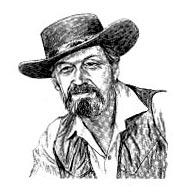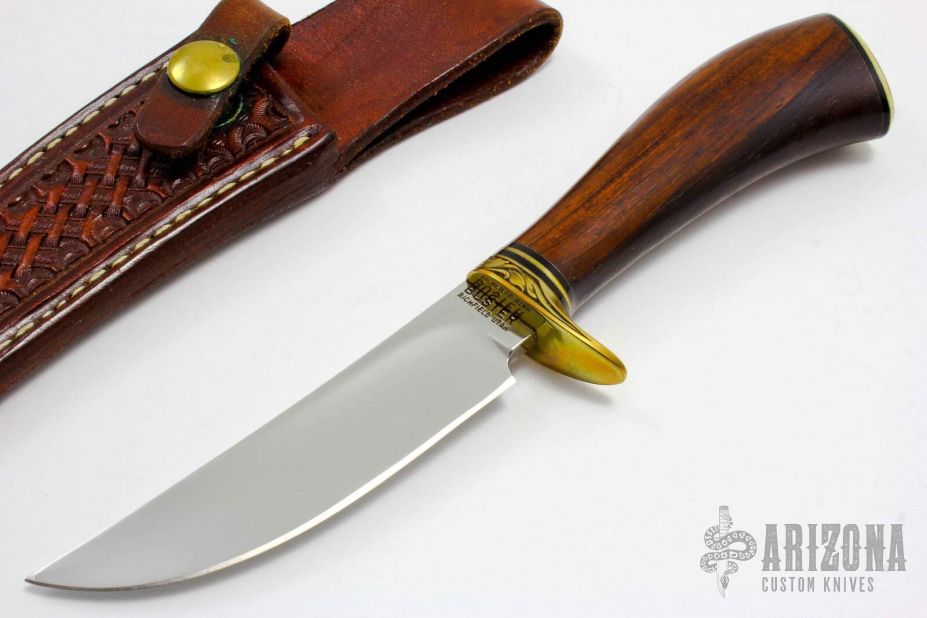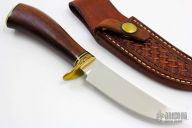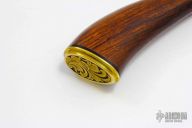Upswept Hunter with J. Warenski Engraving
Price $1,800.00
Product Details
Blade Length 3.75
Overall Length 8.5
Weight (oz) 4.6
Source Previously owned
Additional Specs
Knife Type Has Sheath, Hidden Tang
Blade Details Upswept/Trailing
Handle Material Metallic, Wood
About the Maker

Warenski, Buster
Buster Warenski began making knives as a hobby in 1966 after seeing a picture of a knife made by Gil Hibben. Warenski made his first knife from a file and took it to show Hibben; after seeing Hibben's finished knives, he toured Hibben's shop and learned some basic techniques from him. In June 1972 he was hired by Harvey Draper to grind blades and assist him at Draper Knives, but the operation went bankrupt by December of the same year. Warenski became a full-time knifemaker in 1975. He was a president of the Knifemakers' Guild for 2 terms and a inductee to the Blade Magazine Cutlery Hall of Fame in 1992. Warenski made knives of all types prior to 1975, specifically hunting knives and skinners, but became famous for his "Art Knives" which he made exclusively after 1975; particularly what became known as his "Legacy Knives". Warenski built a recreation of the gold dagger found in King Tut's tomb. Making the knife took five years and it contained 32 ounces of gold including a blade cast from gold and specially heat treated. This knife was a stand-alone project, but became the first of his "Legacy Knives". He followed this knife with a knife he called "The Gem of the Orient", which incorporated 153 emeralds totalling 10 karats and 9 diamonds with a total weight of 5 karats. These gems were set to accent the gold filigree which overlaid the jade handle. It took Warenski 10 years to make this knife and it was sold for $2.1 million (US). The third knife in this series was named "Fire and Ice"; this knife contained 28 ounces of 18K gold, 22 rubies totaling 4.25 karats and 75 diamonds totaling 7 karats. The handle for this knife was constructed of quartz, accented with red enamel. A fourth knife was planned, but not finished. With the exception of any damascus steel used in the knives, which Warenski ordered as a blank from an ABS Mastersmith and ground himself, all of his knives were sole-authorship, meaning he made and finished every part of the knife including making sheaths and engraving. After 1986, his wife, Julie Warenski, aided him with the engraving and gold embellishments. Warenski passed away in 2005.
Warenski, Julie
My career in custom knifemaking began in 1986 when I met Buster Warenski who taught me the art of engraving. I was taking an engraving class, which he taught, and later that year we were married. Within one year I was engraving every knife we made and also engraved for many other knifemakers and customers all over the world. Over the years I worked in many areas of knifemaking helping with knife designs and also making many parts of our knives, as well as doing all the embellishment on them. We had a great marriage and awesome relationship until he was so unexpectedly taken away forever. He used to joke that he was going to teach me how to grind the blades so he could just retire, but I quickly let him know that there was no way this was going to happen. I often wish now that he had taught me his techniques to grind the knife blades. After Buster’s passing, I had a strong desire to make knives and continue to make the great art knives that I had worked on and had a unique partnership with for the past 20 years. A past student of Buster’s, Curt Erickson, had offered to help teach me to grind the way Buster had taught him. He was the only person Buster had really tutored in knifemaking and I graciously accepted his offer. After working with Curt and with his help I won the Buster Warenski award for the best Art Knife at the New York knife show in February 2006. We were married in 2006, and now work together in a new and exciting partnership in knifemaking. There will be many fabulous knives in our future together as we are dedicated to making some of the best art knives possible.






